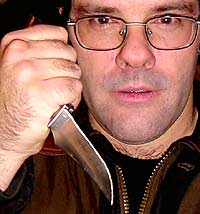The Knife - Weapon Of Fear
Part I - Assessing The Threat
by R. J. Nash

Editor's Note: Facing anyone with
a knife is a very dangerous situation. You can easily be severely injured
or even killed. It is foolhardy to try to fight a knife wielding antagonist
without extensive training and practice under the guidance of an expert
teacher. Without training the best option is just to escape or run away.
Confrontation with a knife wielding assailant is frightening at best.
It can also kill you.
But most people aren't trained in how to react, even though the knife
is one of the most common weapons carried on the streets today, either
as a weapon of violence or as a defensive weapon.
The most common self-defense request I receive in the dojo is from people
who wish to learn knife defense. Many experts will tell you that you should
always surrender to the knife. I firmly believe that with proper training
and understanding of the subject, learning knife defense is a valid option
to surrender.
Threat awareness and assessment
This subject is multitudinous. It covers everything from being aware
that you should not go to certain areas displaying your gold Rolex watch,
to not standing next to an aggressive drunk in a bar.
Criminals, whether they be rapists, muggers, street gang members or just
thugs, understand the fear that most people feel when threatened with
a knife. The knife is a fearful weapon because of the massive damage that
can be inflicted with it. This is often depicted in the "stab and
slash" horror movies, simply to stimulate the fear thrill responses
of the audience, and thereby conditioning people to have the knife as
their number one weapon of fear.
There are three main categories of people who carry knives. First, there
is the criminal. The rapist or mugger/robber. The criminal is likely to
carry a large "Rambo" type combat knife for its visual impact.
Second, there is the gang member or hardened thug. His weapon is likely
to be a switch-blade or craft-type knife as his intention, more often,
is to slash rather than kill. Third, there is the timid coward, who is
likely to carry a sheath-type knife as his intention is only to pull the
knife to dissuade anyone from attacking him.
Understanding the common psychology of the three groups and the way in
which they employ the knife is the first step in learning to combat this
weapon.
1. The Rapist/Mugger/Robber
Threat: He or she usually does not have the intention to harm
you, but to force your compliance through fear of what will happen if
you resist.
Response: Immediate action is the safest option in dealing with
this danger if you have no intention of surrendering to the threat. Because
of the fear factor that the assailant expects you to have, he or she is
mentally unprepared to face an immediate defensive response.
2. The Hardened Thug
Threat: He or she actually wants to use the weapon. This is because
the thug perceives his or her status of "hard man or woman"
to be enhanced by its use. The knife is likely to be easily concealed,
and the attack is most likely to be a surprise one. The thug is the most
dangerous person to defend against because of his mind-set and previous
experiences. Also the attack is likely to come as part of a gang attack.
Response: An effective response takes proper training in awareness,
assessment and repetitious technique training. If this is done, the risk
can be minimized
3. The Timid Coward
Threat: He or she has no real desire ever to use the knife and
is only likely to draw the knife if a real threat is perceived.
Response: This threat is probably the easiest to defend against
since the coward has no desire to use the weapon. Once the knife is drawn,
if you back away and leave him or her room to escape, it is highly unlikely
that there will be an attack. However, if pushed, the knife carrier can
become a great danger due to his panic.
Learning Knife Defense
Too many instructors fail to differentiate between the defenses for "knife
threat" and "knife attack," and too much time is devoted
to defending against attacks. Successful defense against "threat"
prevents "attack!"
For the first example I use the mugger scenario.
Your awareness has failed and the mugger has drawn a knife and threatened
you. Your assessment training has made you understand that because of
the mugger's experience, he knows there is a brief period of shock before
you accept the situation. He will expect to have to repeat his demand
for your money. Use this brief period to judge how the knife is positioned.
For example, how close is the knife? Is it pointed to your face or body?
Has the mugger a hold on your clothing? From this you can determine your
response.
The second example is where the thug seems to be deliberately goading
you to violence.
When facing anyone who is in an aggressive mood and likely to turn violent,
there are two golden rules:

Rule number one is that you must always maintain
your "exclusion zone." This zone is an area in which you are
just out of reach of the aggressor.

Rule number two is that you must ensure that you can see both
of the aggressor's hands. If he has one hand inside his clothing or in
a pocket, back away and leave the area if possible. If he has one hand
hidden behind his body or down behind his leg, again, back away and leave
the area if possible. If the hand is hidden you must move to try and see
the hand. If he moves to keep the hand obscured and you cannot back away,
you must assume that he is hiding a weapon and you should immediately
use a pre-emptive technique for your own safety.
Future articles will discuss combating the fear of facing the knife and
how to deal with some common threats and attacks.
About The Author:
Rodney Jefferson-Nash, 5th dan, is Chief Instructor of the Tora Kai
Karate Association located in Eastern England. He also holds a dan ranking
in Aikido amd Kenjutsu and has for many years cross-trained in both
Jujutsu and Judo. His training began in 1960. He is a career soldier
and British Army combat instructor. He also works as a security consultant.
|